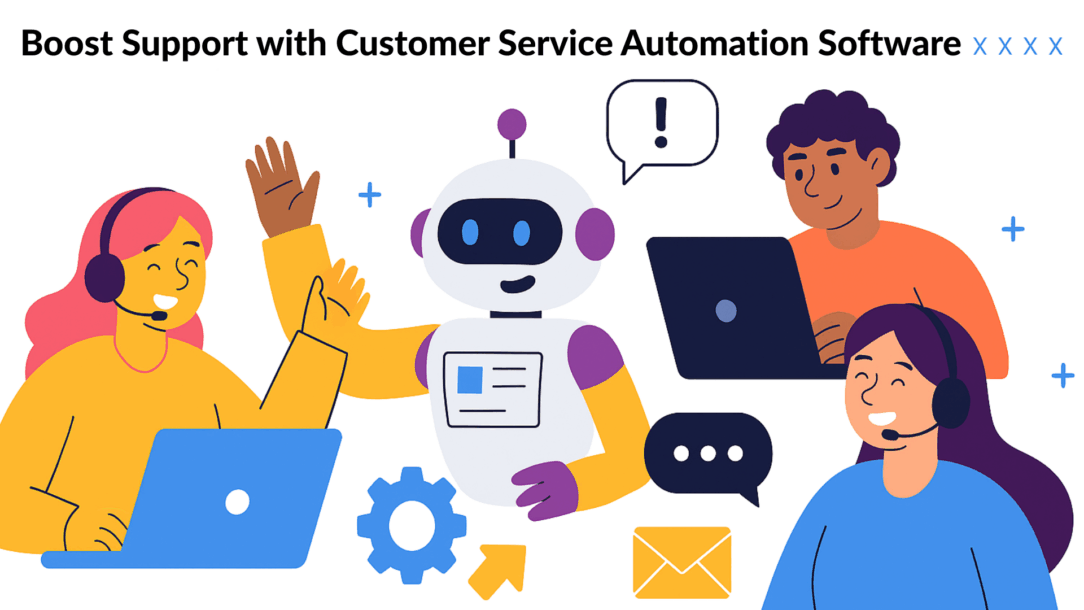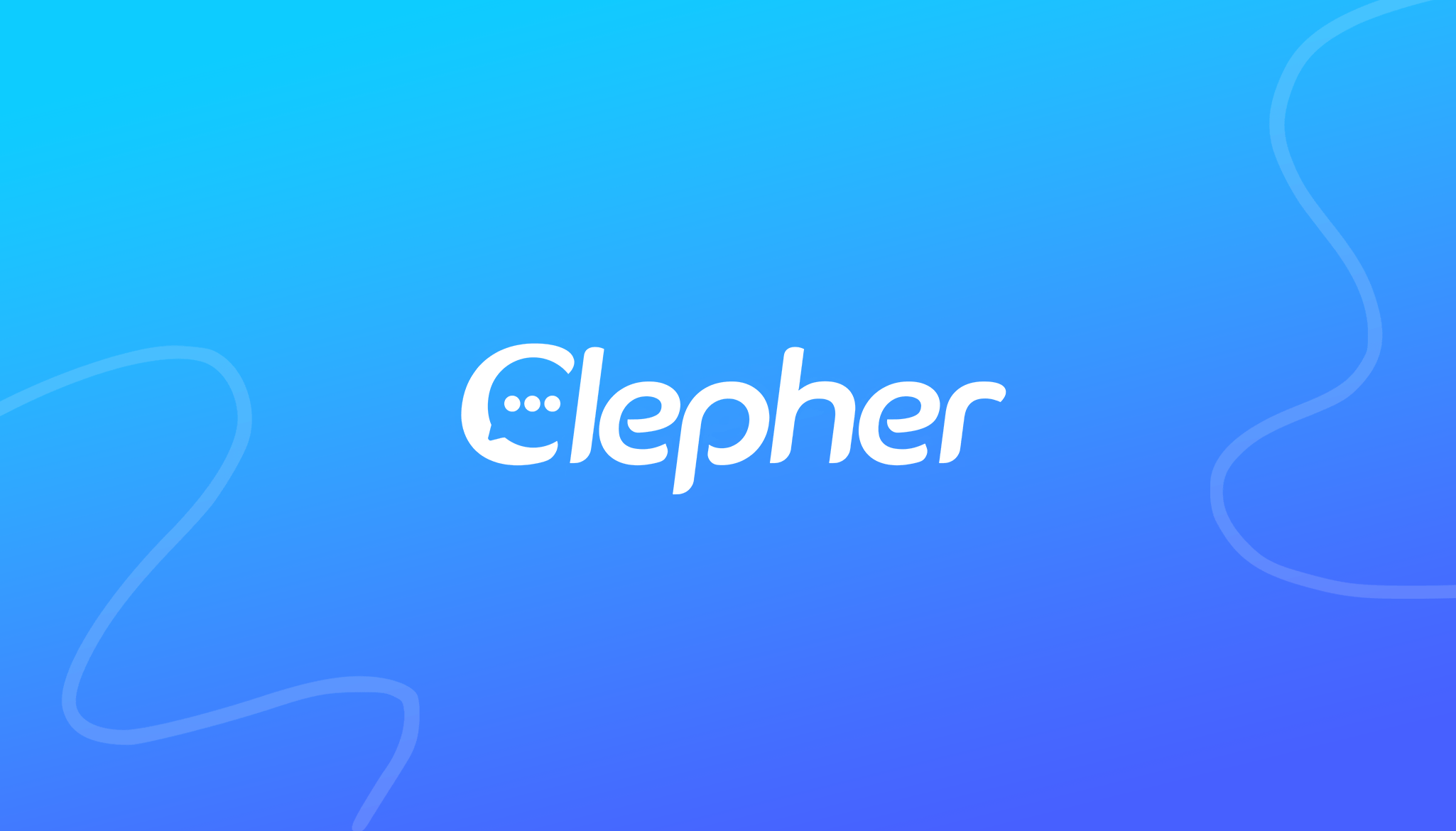Imagine your support team had the perfect assistant. It never sleeps, never takes a break, and instantly handles the repetitive questions flooding your inbox. That’s the power of customer service automation software.
This isn’t about replacing your human agents. It’s about empowering them. By automating the predictable, you free up your team to solve the complex, high-value problems where they truly shine.
Want to automate customer service for your business? Buckle up and read!
What Is Customer Service Automation Software?
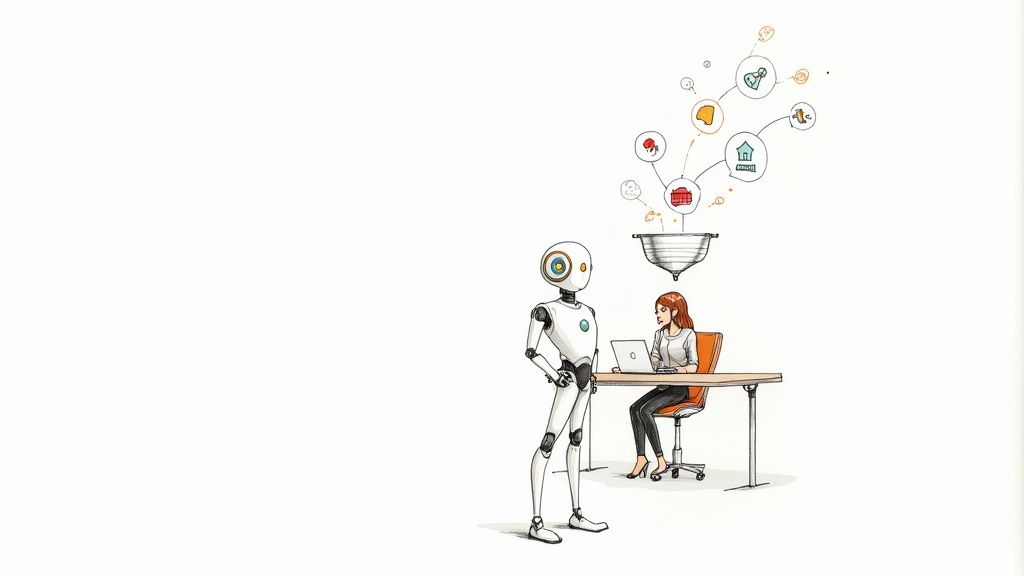
customer service automation
At its core, customer service automation software acts as a smart filter. It uses technology to manage and resolve common customer inquiries with little to no human help. Think of it as handling the high-volume, low-effort tasks, so your team can focus on the conversations that build relationships.
This shift transforms your support from a reactive fire-fighting crew into a proactive problem-solving team. The result is a win-win: happier customers get instant answers, and your agents feel more engaged and fulfilled.
Moving Beyond Basic Support
Effective automation is more than just canned responses. It’s about streamlining entire processes. This is where a broader understanding of workflow automation becomes crucial, as it’s the engine driving these smart systems.
Let’s use a practical example: a product return. Traditionally, this is a multi-step headache for your team. With automation, the workflow looks like this:
- A customer starts a return via a chatbot on your website.
- The system instantly validates their order number and purchase date.
- It generates a shipping label and emails it directly to the customer.
- The workflow then tracks the return shipment and sends updates.
This entire sequence happens without a single support ticket hitting an agent’s queue. It’s a perfect use case for improving customer support with chatbots while eliminating manual work.
Key Takeaway: The goal of automation isn’t to eliminate human interaction. It’s to reserve it for the moments that matter most. Let the software handle the predictable, so your team can manage the exceptional.
Many businesses still grapple with the same support bottlenecks. Let’s break down these common pain points and see how automation provides a direct, actionable solution to boost customer acquisition.
Common Support Challenges and Automation Solutions
| Common Problem | How Automation Solves It (The Actionable Fix) |
|---|---|
| Slow Response Times | Deploy a chatbot to provide instant, 24/7 answers to common questions, eliminating customer wait times. |
| High Ticket Volume | Automate routine inquiries like password resets or order status checks, deflecting them before they reach a human. |
| Agent Burnout | Offload repetitive tasks, allowing agents to focus on engaging in complex problem-solving that boosts job satisfaction. |
| Inconsistent Answers | Ensure every customer receives the same accurate, pre-approved information, maintaining brand consistency. |
| Difficulty Scaling | Handle thousands of simultaneous conversations without hiring more staff, making business growth manageable and cost-effective. |
This table clearly shows how automation directly tackles the biggest operational headaches preventing support teams from delivering exceptional service.
The Growing Demand for Automation
This strategic shift is no longer a niche trend; it’s the new industry standard.
The global customer service automation market was valued at USD 3.5 billion in 2023 and is projected to skyrocket to USD 15.8 billion by 2032. This explosive growth proves that businesses are racing to adopt more efficient, scalable support solutions to stay competitive.
The Real-World Benefits of Automating Support
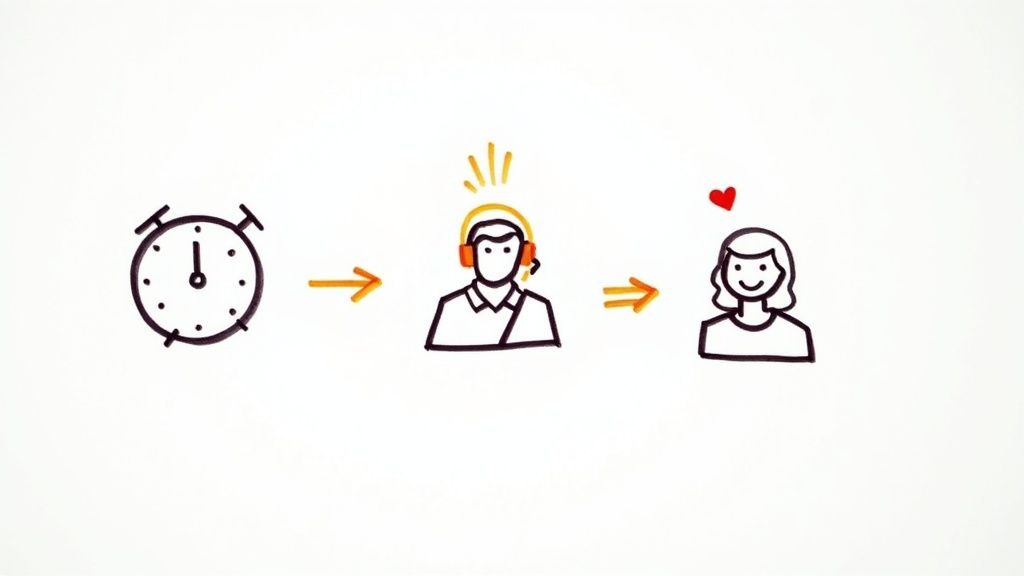
benefits of automating support
Let’s move past theory and talk about results. The true value of customer service automation is measured in tangible, game-changing outcomes for your business, your team, and your customers.
This isn’t a small trend. The customer service software market projections from Cognitive Market Research show the market is expected to more than double from $7.78 billion in 2021 to over $16 billion by 2025. This explosive growth across all sectors proves one thing: automation is a key competitive advantage.
Gain Significant Operational Wins
The most immediate benefit is a massive boost in efficiency. Automation works 24/7, meaning you can offer genuine round-the-clock support. A customer with a question at 2 AM gets an instant answer from a chatbot instead of waiting for business hours.
This 24/7 availability causes resolution times to plummet. Instead of tickets piling up, automation deflects a huge portion of them. This frees your agents to tackle complex issues faster when they start their day.
Actionable Insight: By handling a high volume of simple inquiries instantly, you can scale your support operations without proportionally scaling your headcount. This means you can grow your business without overwhelming your team or budget.
Empower and Retain Your Support Agents
Let’s be real: great support agents burn out on repetitive tasks. Automation acts as their shield. By taking on the monotonous work—password resets, order tracking, FAQs—it allows agents to use their brainpower where it truly matters.
This shift transforms their role from script-readers into expert consultants. Instead of answering the same question for the hundredth time, they’re handling tricky escalations, turning frustrated customers into loyal fans, and providing high-value, personal service.
This empowerment leads directly to tangible results:
- Reduced agent burnout: Happier, more engaged agents stay longer.
- Lower turnover rates: Retaining experienced staff is far more cost-effective than constantly hiring and training new people.
- A more skilled team: Agents have time for professional development, deepening their product knowledge and support skills.
Deliver a Superior Customer Experience
Ultimately, every benefit circles back to the customer. Fast, consistent, and always-available support drives customer satisfaction through the roof. People love getting immediate answers without sitting on hold or waiting for an email reply.
That instant gratification builds trust and loyalty. A customer who tracks their package in seconds via a chatbot is more likely to buy from you again than one who navigates a clunky phone menu. By creating a frictionless support journey, you’re not just solving a problem—you’re strengthening the customer relationship and building a reputation for incredible service.
Essential Features Your Automation Software Must Have
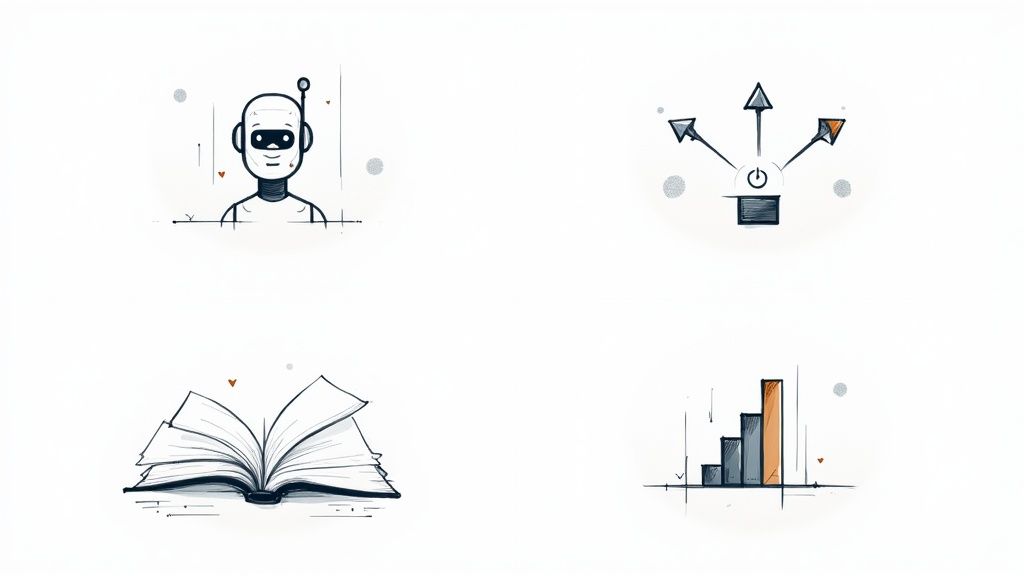
must-have features of your automation software
Choosing the right customer service automation software can be overwhelming. Let’s cut through the noise and focus on the non-negotiables. A great platform is a complete system designed to make your support smarter, faster, and more efficient.
AI-Powered Chatbots and Intelligent Responses
This is your starting point. Modern AI-powered chatbots use natural language processing (NLP) to understand how real people talk, leading to fluid, helpful conversations. They can instantly handle routine tasks like order status checks, product questions, or appointment scheduling, 24/7.
This speed is critical. A huge 71% of consumers now expect businesses to communicate in real-time. The goal is to solve simple problems on the spot, so your team doesn’t have to. For a deeper dive, understanding what is smart response technology is key to making interactions feel effortless.
Automated Workflows and Ticket Routing
A great platform goes beyond simple Q&A. It should manage entire processes with automated workflows.
Real-World Example: Imagine a customer wants to process a return. An automated workflow can:
- Verify the purchase by connecting to your e-commerce system.
- Generate and email a shipping label automatically.
- Track the package and trigger a refund upon its arrival.
This entire process unfolds without creating a single support ticket. But what if the issue is too complex for a bot? That’s where intelligent ticket routing steps in. The system analyzes the request and sends it to the best-suited agent based on their skills or department, eliminating manual sorting.
Self-Service Knowledge Base
One of the easiest ways to reduce ticket volume is by empowering customers to help themselves. The best automation software integrates with or helps you build a powerful self-service knowledge base.
Actionable Insight: A strong knowledge base is your first line of defense. It deflects simple questions before they ever reach your team, freeing up agents for high-stakes problems that require a human touch.
Modern tools even use AI to spot gaps in your help content. By analyzing chats, the system can identify common questions that lack a clear answer and suggest new articles to create. Your knowledge base becomes a living resource that gets smarter over time.
Robust Analytics and Reporting
You can’t improve what you don’t measure. Clear, straightforward analytics are a must-have for understanding your support performance.
Your dashboard should track key metrics like:
- Ticket Deflection Rate: How many queries are successfully handled by automation?
- First-Contact Resolution: What percentage of issues are solved in the first interaction?
- Customer Satisfaction (CSAT): Are customers happy with both automated and human support?
This data isn’t just for show. It helps you identify weak spots, fine-tune your workflows, and prove the ROI of your automation efforts.
How Top Businesses Win with Customer Automation
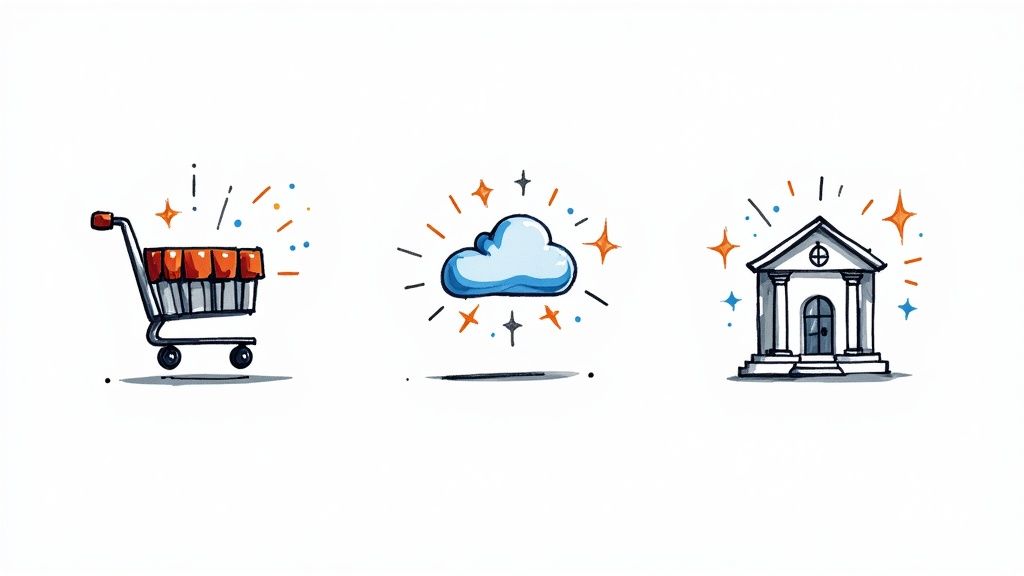
top businesses and automation
Seeing customer service automation in action makes its value click. Leading businesses use this tech to build a serious competitive advantage by fundamentally changing the rules of customer interaction.
E-commerce Brands Mastering Order Inquiries
Use Case: An online fashion retailer was buried under “Where is my order?” (WISMO) requests. By implementing a chatbot powered by customer service automation software, they automated 80% of all order status inquiries.
The Result: Their expert agents were freed up to handle high-value conversations like sizing advice, styling tips, and product recommendations. Customers got instant 24/7 tracking updates, and agents focused on interactions that drive sales and build loyalty.
Key Takeaway: This shift transforms support from a cost center into a growth engine by reallocating your team’s expertise to conversations that matter most.
SaaS Companies Slashing Support Tickets
Use Case: A SaaS company was drowning in repetitive questions about software features. They built a self-service portal powered by an AI-driven knowledge base that understood user questions and served up precise answers.
The Result: They slashed their overall support ticket volume by 40%. This allowed their technical support team to focus on critical bugs and high-priority issues, dramatically improving resolution times.
Financial Services Ensuring Security and Speed
Use Case: A financial firm deployed a secure chatbot to handle common account questions and identity verification. Using secure connections, the system instantly checks user details and provides information on balances or recent transactions.
The Result: Customers get immediate, secure access to their information without waiting on hold. This trend is accelerating. Forecasts show that by 2025, 95% of all customer interactions will involve AI, and by 2026, 10% of agent interactions will be fully automated.
Choosing the Right Automation Software for Your Business
Picking the right software is a strategic decision. Get it right, and you’ll transform your support operations. Get it wrong, and you’re stuck with a tool that creates more problems than it solves. The goal is to find a solution that scales with you, integrates seamlessly, and empowers your team.
Evaluate Scalability and Future Growth
The software you choose must grow with you. Can it handle a massive spike in chats during a Black Friday sale? A platform that works for 1,000 monthly conversations might crash under the pressure of 100,000.
You need a solution built for growth. Look for platforms that can manage an unlimited number of subscribers and conversations without performance issues. Tools like Clepher are designed with this scalability in mind, ensuring your automation engine runs smoothly as your business expands.
Prioritize Seamless Integrations
Your automation software cannot exist in a vacuum. It must communicate flawlessly with your other critical tools, like your CRM, e-commerce platform, or email marketing service. Without simple integrations, you create data silos and manual work, defeating the purpose of automation.
A top-tier platform should offer a wide range of native integrations and also connect to services like Zapier or Make for maximum flexibility. For example, Clepher connects to over 50 apps natively, enabling you to:
- Automatically update customer CRM profiles after a chat.
- Trigger an abandoned cart email sequence from a Messenger conversation.
- Sync new subscribers directly to your email list.
This creates a unified system where data flows freely, giving your team a 360-degree view of every customer.
Demand an Intuitive User Experience
The most powerful software is useless if your team finds it too confusing. A steep learning curve means slow adoption and wasted time.
Look for a no-code, drag-and-drop builder. This is non-negotiable. Your marketing and support teams should be able to design, test, and launch a conversational workflow without writing code. An intuitive interface empowers them to build their own solutions, making them more invested in the platform’s success.
Actionable Insight: A great user experience is a direct driver of ROI. When your team can build and tweak workflows on the fly, they can respond to changing customer needs with incredible agility.
Finally, examine the pricing model. Is it transparent and predictable? Find a partner with a clear pricing structure that fits your budget and delivers obvious value from day one.
Software Evaluation Checklist
Use this checklist to systematically compare platforms and make a data-driven decision.
| Evaluation Criteria | What to Look For | Why It Matters |
|---|---|---|
| Scalability | Unlimited contacts/conversations, stable performance under high volume. | Your software must grow with you, not hold you back during peak seasons. |
| Integrations | Native connections to your CRM, e-commerce, and email tools. Zapier/Make support. | Avoids data silos and manual work, creating a complete customer view. |
| User Experience (UX) | No-code, drag-and-drop interface with minimal training required. | Empowers non-technical teams to build and manage automation, accelerating ROI. |
| Channel Support | Covers all channels where your customers are (e.g., Messenger, Instagram, Web Chat). | Meet customers where they are with a true omnichannel platform. |
| Analytics & Reporting | Clear dashboards on bot performance, user engagement, and conversation trends. | Data helps you optimize flows, understand customer behavior, and prove value. |
| Support & Onboarding | Responsive customer support, detailed documentation, and a helpful community. | A reliable partner is crucial when you hit a roadblock and need help quickly. |
| Pricing Model | Transparent, predictable tiers without hidden fees for core features. | A clear pricing structure prevents budget surprises and ensures you’re getting value. |
This checklist helps you focus on the features that will actually make a difference, ensuring you choose a long-term partner, not a short-term fix.
How to Build Your First Automation Workflow
Getting started with automation is easier than you think. The key is to start small. Don’t try to solve every problem at once. Instead, focus on one high-impact issue to get a quick win.
Let’s walk through a classic e-commerce example: automating “Where Is My Order?” (WISMO) questions. These requests are repetitive, straightforward, and perfect for your first project.
Step 1: Identify Your Starting Point
First, find the pain point. What question is clogging your inbox and wasting your team’s time? For most online stores, WISMO inquiries are the #1 culprit. They are high-volume but low-complexity, making them the ideal candidate for automation.
By choosing a common, predictable query, you guarantee an immediate and noticeable impact. The goal is a decisive victory that proves the power of automation right away.
Step 2: Map the Conversational Flow
Next, sketch out the conversation. Keep it simple. A straight-line path is perfect for your first workflow.
Think of it like writing a mini-script for your bot. A typical WISMO flow looks like this:
- Greeting: The chatbot offers a friendly welcome.
- Intent Recognition: It identifies keywords like “order status,” “tracking,” or “where’s my package.”
- Data Request: The bot politely asks for the customer’s order number or email.
- Information Delivery: It pulls the live shipping status and provides a real-time update.
- Closing: It asks if the customer needs help with anything else.
This basic structure handles the entire interaction. For more advanced strategies, our guide on how to build a chatbot offers deeper tips.
Step 3: Connect Your Data Sources
This is where the magic happens. To provide real-time updates, your customer service automation software must connect to your other systems, like your e-commerce platform (Shopify, WooCommerce) or order management system.
Platforms like Clepher are built for this, offering simple, native integrations.
Once connected, the chatbot can use the order number to pull live tracking information directly from the source. This ensures every answer is 100% accurate and up-to-date, which is critical for building customer trust in your automated assistant.
Key Insight: A great workflow is powered by live data. This connection transforms your chatbot from a simple FAQ machine into a dynamic, problem-solving tool that delivers real value.
Step 4: Test and Launch Your Workflow
Before going live, test your workflow thoroughly. Act like a customer. Run through the conversation, try different phrasing, and look for any dead ends or confusing responses. Ensure the replies are clear, helpful, and match your brand’s tone.
Once you’re confident it’s working smoothly, launch it. You’ll be amazed at how quickly this single automation starts deflecting tickets and freeing up your team. It’s the fastest way to see an immediate return on your investment.
Understanding Customer Service Automation: Key Insights
Defining Customer Service Automation Software
Customer service automation software encompasses a range of tools designed to simplify and enhance the way businesses manage customer interactions. These systems automate routine processes, allowing teams to deliver faster, more efficient, and consistent support experiences.
Strengthening Loyalty Through Automation
Automation in customer support plays a pivotal role in building long-term loyalty. By ensuring timely and personalized responses, businesses can meet customer needs more efficiently, creating positive experiences that encourage repeat engagement and trust.
Essential Features for Effective Automation
When evaluating customer service automation tools, it’s important to focus on capabilities that drive real impact—such as automated replies, feedback tracking and analysis, and integration with existing communication platforms. These features collectively enhance workflow and optimize overall service management.
Influence on Key Service Metrics
The adoption of automation technology can lead to measurable improvements across customer service metrics. Businesses often see reduced response times, higher satisfaction scores, and deeper insights into customer behavior, enabling smarter decision-making and performance optimization.
Balancing Automation and Human Support
While automation excels in managing repetitive and straightforward queries, it should complement—not replace—human expertise. Complex issues still require the empathy and critical thinking that only a trained customer service team can provide. A balanced approach ensures both efficiency and authenticity in every customer interaction.
Conclusion
Leveraging customer service automation software is essential for businesses that aim to enhance customer experience and satisfaction. You can utilize automation tools to better understand customer, meet customer needs, and streamline their service processes, allowing customer support teams to handle customer inquiries and complex issues efficiently. With features such as ticketing systems and customer communications, businesses can better track customer interactions and optimize their customer service operations.
Implementing automation software like Salesforce Service Cloud empowers teams to focus on delivering exceptional customer experiences while maintaining high-quality service. The integration of AI-powered customer service solutions can further enhance customer engagement, providing personalized service that meets customer expectations and builds loyalty.
As we look towards automation software in 2025, it becomes increasingly clear that automation at scale will revolutionize the way businesses handle customer requests and feedback. By automating service tasks, companies can respond to customer queries more effectively, improve service quality, and ultimately ensure a better customer journey. Investing in customer service automation not only aids in managing customer relationships but also contributes to customer success and retention, making it a critical strategy for any forward-thinking organization.
Related Posts

